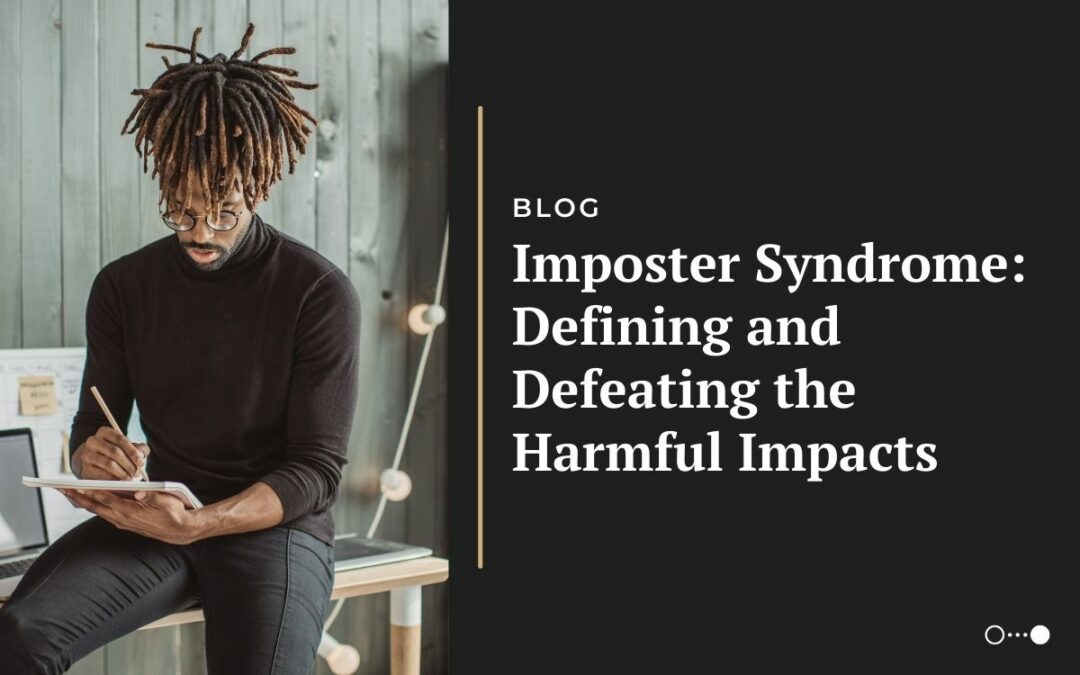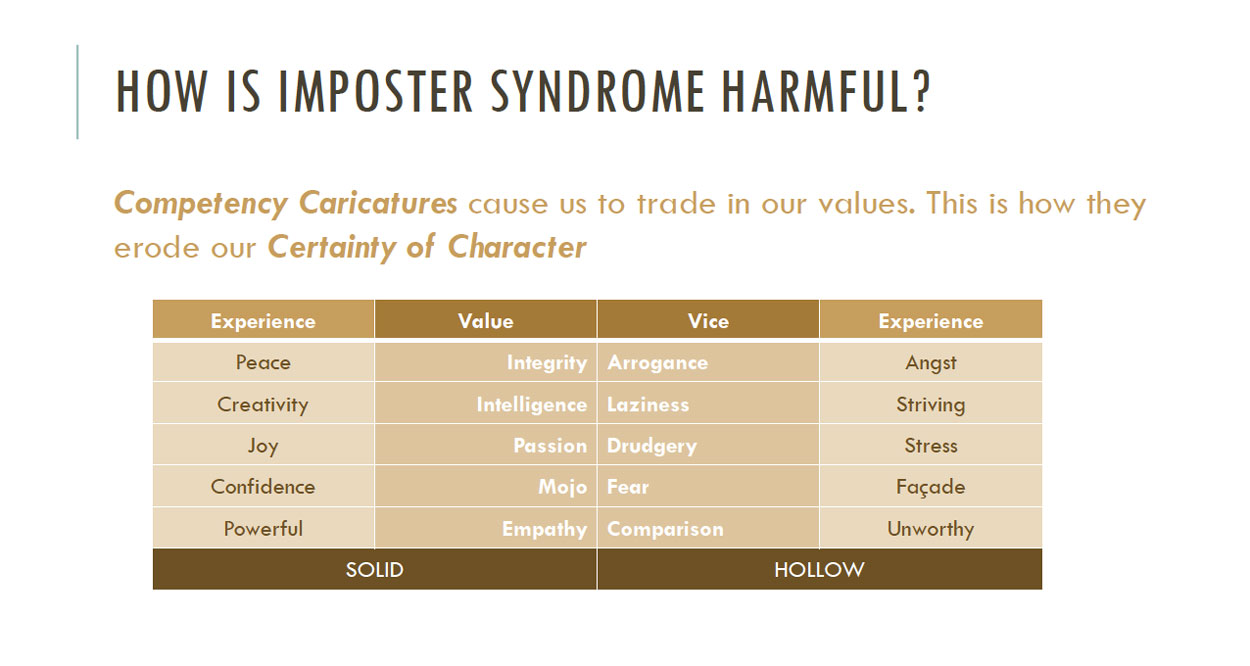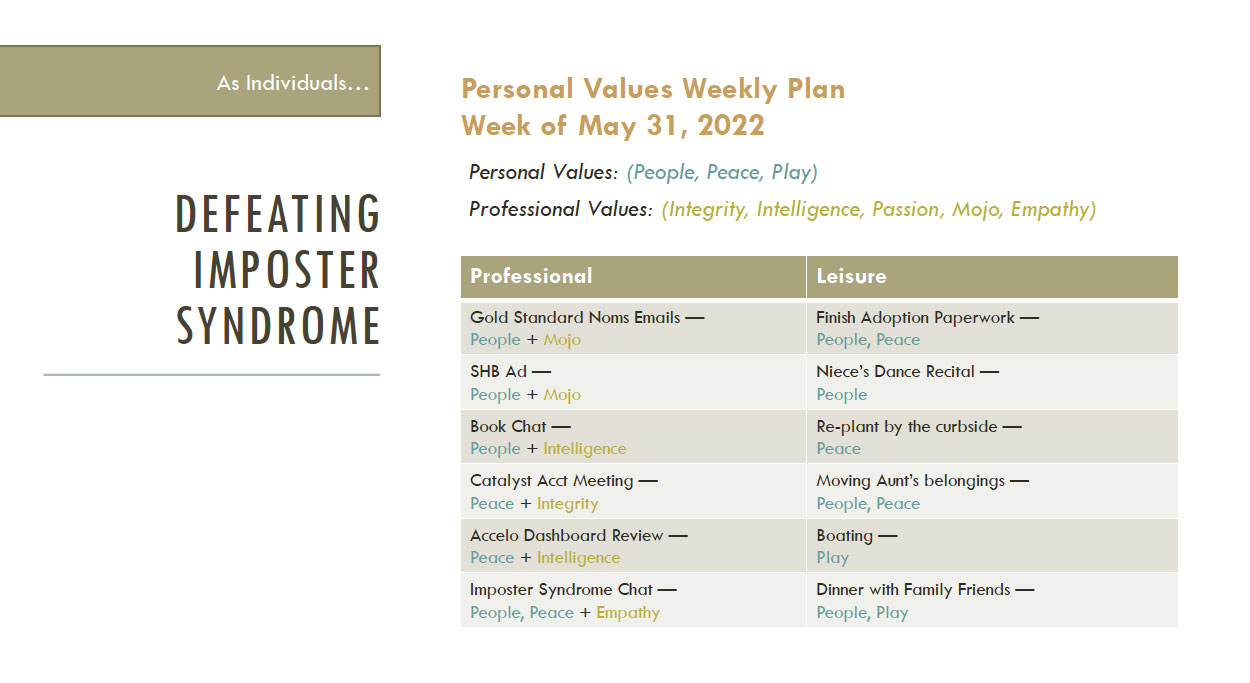Mental Health Awareness Month may already be in the books for 2022, but it’s always a good time to talk about ways we can boost mental health in the workplace. In May 2022, our team had a couple discussions about imposter syndrome: defining it and talking about ways to defeat the harmful impact.
Although it’s not an official diagnosis listed in the Diagnostic and Statistical Manual of Mental Disorders (DSM), the American Psychological Association (APA) acknowledges the validity of imposter syndrome as a real condition with tangible effects. It is defined loosely as the inability to accurately internalize successes and the experience of significant self-doubt in your own abilities. It is often accompanied by feelings of anxiety, depression, and a sense of impending doom that you are a phony on the verge of being found out.
One of the biggest challenges in overcoming imposter syndrome is the fact that it thrives in isolation. “By definition, most people with impostor feelings suffer in silence,” says Suzanne Imes, Ph.D., a clinical psychologist with a private practice in Georgia who was one of the first to describe imposter syndrome in the 1970s. “Most people don’t talk about it. Part of the experience is that they’re afraid they’re going to be found out,” she said to the APA.
It is estimated that up to 82% of people from varying backgrounds, social status, skill levels, and degrees of expertise will experience this phenomenon at least once in their lifetime. In the remote work era, where isolation can be one of the downsides to the many upsides of this new way of work, imposter syndrome may have even more fertile ground in our minds if we are not positioned well to prevent it.
At Catalyst, we’re always working on bringing these kinds of dynamics into the light so that our team members do not suffer alone with needless attacks on mental health. Aside from anxiety and depression, imposter syndrome is known to also impair job performance and job satisfaction, and be a causal factor in burnout, leading to early or frequent departures from roles that people are actually quite successful in.
Our goal is to help one another see the struggles we all silently identify with, discuss them, develop a language for it, and design a culture that self-heals by way of these dialogues. During our team discussions, we reviewed much of the modern research that has been done and discussed key points. One area of interest was the five competence types, or “imposters,” defined by Dr. Valerie Young that reflect internal beliefs about what competency means to different people. Many on our team commented to being awakened to ways they didn’t realize they experienced imposter syndrome when viewed through the lens of the perfectionist, the superhero, the expert, the natural genius, and the soloist.
The current body of research suggests a number of meaningful ways to fight off imposter syndrome. Some of the methods include acknowledging and sharing your feelings with others, building connections by working in teams, focusing on others who may need encouragement, challenging your own doubts with objective facts, and avoiding comparison and limiting time on social media.
As our group talked, we identified some areas perhaps not addressed as directly by current research. One dynamic we identified is that, within a team, if a number of people are experiencing imposter syndrome — aligning mentally more with their imposters or competency caricatures, and striving to prove themselves against a set of internal doubts — it creates a lot of unspoken layers for potential miscommunications. As we go about our daily work, we also seek cues — verbal and non-verbal, written quickly or slowly, punctuated or with an emoji, hearted or only thumbs-upped, GIF or meme, said or left unsaid — to find affirmation in the responses of others, doing a sort of work beneath the work on a personal and a professional level at the same time. It’s exhausting! And over time, the work beneath the work can drag down not just an individual, but their relationships as well, and begin to infect a team with a sort of fear-based, bait-laden reflex to what would otherwise be healthy working relationships.
As a group, we identified that if we respond to each other out of this place of fear or self-doubt, it forms habits that harden in a way where we lose grip on our corporate values and the intended emotional experience of abiding in those values. In place of our ideal selves comes these weaker, more fearful specters that haunt our thoughts and feelings.
We charted out the concept below as a conversation piece to see how we move from a solid sense of identity in the workplace to a hollow sense as fear takes its place in us. Our corporate values being Integrity, Intelligence, Passion, Mojo, and Empathy, we talked about what emerges in us when those values erode. Instead of experiencing the solidity of peace, creativity, joy, confidence, and healthy feelings of power, we have a hollower experience of angst, striving, stress, facades, and feelings of unworthiness. Many would have different words for how the experience shifts for them personally, but there seemed to be some agreement that there’s a double-sided coin to corporate values, and imposter syndrome can have some bearing on it.
To create a more strategic plan to defeat imposter syndrome’s harmful effects, we looked at it from this value-level viewpoint and developed a plan to reverse engineer the condition. On a very practical level, we reminded the team of our philosophy of hiring and that they were already chosen and proven through the interview process. So much evidence exists of their strengths and contributions, their value to their colleagues, and tangible wins like awards, client testimonials, and sheer revenue. We reminded the team that any time at all, managers are keen to have one-on-ones to reiterate those strengths as needed and reinforce the value of intentional feedback.
On an even deeper note, we discussed a practical strategy for defining personal values alongside our professional values. This way, we can establish personal meaning and a connection to corporate values, and look at assignments and portions of our role as part of an expression of our own personal values. The following table shows an example of a work week laid out alongside a personal week to see the simple execution of this plan. You can see where personal values and professional values are meeting in an intersection in both professional and leisure aspects of life. Designing quality leisure time is part of the formula!
A simple ritual like this has the effect of adding a sense of solidity and intention, against which the voice of imposter syndrome can decrease to a whisper or vanish completely. Imposter syndrome tries to convince us that we’re not real, we’re hollow, we’re fake, and we’re being found out as we speak. Incorporating a weekly routine of planning moments and marking wins where values were upheld not only diminishes the voice that we might be phonies, it also ensures we’re maximizing those very real powers that lie within. It can serve as the undeniable truth to the contrary and even help rewire the brain’s neural pathways to a better set of beliefs about ourselves.
See the flipbook for a glance at our full deck and conversation. You can also download a template for the personal-x-professional values planner here, and read the helpful articles and resources referenced in our discussions.
Helpful Articles:
https://www.healthline.com/health/mental-health/imposter-syndrome#signs
https://www.verywellmind.com/imposter-syndrome-and-social-anxiety-disorder-4156469
https://www.apa.org/gradpsych/2013/11/fraud
https://hbr.org/2021/02/stop-telling-women-they-have-imposter-syndrome
https://www.entrepreneur.com/slideshow/304273
https://impostorsyndrome.com
Studies:
https://www.ncbi.nlm.nih.gov/pmc/articles/PMC7174434/
https://so06.tci-thaijo.org/index.php/IJBS/article/view/521/pdf



